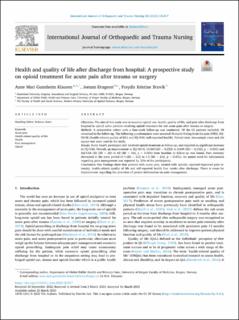Health and quality of life after discharge from hospital: A prospective study on opioid treatment for acute pain after trauma or surgery
Journal article, Peer reviewed
Published version

Åpne
Permanent lenke
https://hdl.handle.net/11250/3068962Utgivelsesdato
2023Metadata
Vis full innførselSamlinger
Originalversjon
International Journal of Orthopaedic and Trauma Nursing. 2023, 50, 101017. 10.1016/j.ijotn.2023.101017Sammendrag
Objectives: The aim of this study was to examine opioid use, health, quality of life, and pain after discharge from hospital in opioid naïve patients receiving opioid treatment for sub acute pain after trauma or surgery.
Methods: A prospective cohort with a four-week follow-up was conducted. Of the 62 patients included, 58 remained in the follow-up. The following questionnaires were assessed: Numeric Rating Scale for pain (NRS), EQ-5D-5L (health-related quality of life) and EQ-VAS (self-reported health). Paired t-test, two-sample t-test and chi square test were used in the study.
Results: Every fourth participant still received opioid treatment at follow-up, and reported no significant increase in EQ-VAS. Overall, an improvement in EQ-5D-5L (0.569 (SD = 0.233) to 0.694 (SD = 0.152), p < 0.001) and EQ-VAS (55 (SD = 20) to 63 (SD = 18), p = 0.001) from baseline to follow-up was found. Pain intensity decreased in the same period (6.4 (SD = 2.2) to 3.5 (SD = 2.6), p < 0.001). An unmet need for information regarding pain management was reported by 32% of the participants.
Conclusions: Our findings show that patients with acute pain, treated with opioids, reported improved pain intensity, health-related quality of life and self-reported health four weeks after discharge. There is room for improvement regarding the provision of patient information on pain management.
